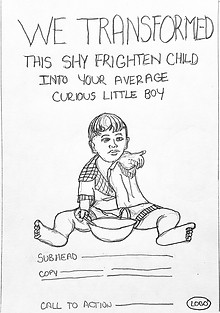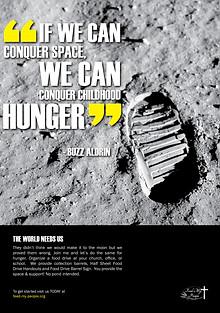Connecting, Synthesizing, Transforming
The Feed My People Foundation (FMP) was a Christian-based non-profit organization in Missouri that faced a significant funding gap. The funds were needed to expand their vision to meet the increasing hunger demands in other surrounding cities due to a shortage of recognition and a decrease in financial contributions. Charitable donation research had shown that donation drives were influenced by campaign messaging and symbols of real victims affected by hunger, homelessness, and neglect (P, 2007). Based on the charitable data, research was conducted for sample ads that used real people who benefitted from charitable financial contributions. These ads would not only serve as a rationale for FMP's campaign but also as an inspiration for design direction.
ad RESEARCH
The 4 samples collected fell into the testimonial category used for effective charity advertising called, “Just Plain Folks;” a real person who was really helped by the organization. Testimonials from real people, unbought and unscripted, have become part of all brands that choose to involve their customers (Felton, G., n.d., P. 246). The "Just Plain Folks" strategy would be the approach for FMP's advertising campaign to help increase their revenue and help identify persuasive testimonies from FMP’s diverse clients. This would communicate a message that would attract a broader audience and employ proven principles for establishing FMP's voice through the subject and writing structure ( Felton, 2013. p. 103).




To get more people interested in their vision, they needed to remind their audience that they were one of the largest foundations of its genre in St. Louis and they offered additional services such as job counseling, healthy kids program, personal development, legal assistance, and other referrals just to name a few. To determine the most effective message for their design problem, an audience profile research was conducted to discover their target audience by generating a fictional persona that represented a specific client within a particular demographic to help guide advertising decisions (Developing Target Audience, 2019).
target audience RESEARCH
A target audience research determined that people had particular needs that were divided into 15 categories and they looked for those particular needs in company products and services. Consumers looked for a product that would not do the least for them but for one that would do the most” (Felton, 2013, p.25). The target audiences for FMP were those who required two particular needs. According to the book, Why They Buy: American Consumers Inside and Out (1986), by Robert B. Settle and Pamela L. Alreck, One need was Recognition: the need to be highly regarded by others, to be held up as a good example. The other was Nurturance: the need to provide care for others, to have and protect (p.25-27). Identifying these needs narrowed the choices down to two profiles that were feasible for FMB to use as key factors to create the advertising campaigns.








The fictitious personas created indicated that the consumer needs strategy would hit its target market and communicate a message that would not only increase company visibility but also influence the audience to donate funds for those in need. The data from the ad samples and target audience research would be synthesized to develop sketch ideas for the ad campaign.






ad concept sketchs
The first design step was 6 concept sketches based on Felton's (1994) testimonial ads, each conveying a different approach supported by headlines to draw the audience to FMP's message and urge them to take action (Rieck, n.d).
From left to right
-
Just Plain Folks: A real person who was helped by the organization (P. 246).
-
Historical figures, unreal people: A world-renowned person from history (p. 241).
-
Not a person. Something associated with the person: An object that takes on human emotions (p. 243).
-
President/CEO, founding mother or father, employee: Experienced by the founder or CEO (p. 241).
-
Extreme use: A person who uses the services of the foundation and is totally satisfied (p. 241).
-
The Expert: Somebody who stands outside the brand and has the expertise to evaluate it (p. 241).
3 strongest concepts
These 3 concept sketches displayed the strongest headline message and would capture the attention of FMP's target audience while reflecting their diverse clients, efficient services, and core values.

Just Plain Folks
This ad conveyed a little boy whose introvert character was overcome by a good nutritional meal. The proof was reflected in his personality.

Historical figures, unreal people
This ad represents a popular astronaut symbol of a risk-taker, a person who challenged assumptions, who dared to be great.

Extreme use
This ad conveyed an over-the-top user who shared a compelling story about how an FMP's volunteer changed his life.
testimonial ads refined
The 3 concepts were defined and converted to color. A testimonial copy was added to each ad that told a personal story that connected with the headline and aimed to trigger the emotions of the audience.



DESIGN PROBLEM
Although the ads had strong messages, the visuals fell short of being defined as an ad campaign. There was no ad consistency with colors, fonts, logos, or images (Consistency is Key, 2017). The challenge was to revise all three ads based on one of the visuals and use common elements in each one to make FMP's brand stronger.
ad series RESEARCH
Ad campaign research steered the design away from the common large image of sad faces to a minimalist approach. The minimalist design would make FMP stand out among there competition and clearly reflect their well-organized charity. The bare-bones nature of the minimalist ad would allow manipulation of the negative space in a way that would draw the viewer's eyes to the key image or message (Dontigney, 2017). The minimalist ad samples were consistent, stood out immediately from the ads below them, and reflected the true essence of an ad campaign.
color scheme
The last revision was the color scheme. According to Branding & Color Tips (2016), colors are important in advertising and are normally used to reflect certain values. For that reason, colors were used that accurately represent nonprofit organizations and the personality of FMP.
The colors used were:
-
Blue: It represented professionalism, communication, security, trust, peace, and freedom. The true values of FMP
-
Red: Conveys health, anti-violence, food, or lifesaving. The vision of FMP
-
Yellow: Symbolizes energy, clearness, warmth, sun, youth, organization, and cheerful emotions. The character of FMP.
.jpg)

.jpg)



DESIGN SOLUTION
The minimalist approach was successful in delivering the strength of FMP's brand personality, organized structure, core values, and testimonial message to its target audience. The relationship between the images and headlines was more apparent because they were isolated and in the forefront. The connection made between testimonial ad samples, target audience development, ad series research, and color scheme selection were synthesized and transformed into an effective ad campaign that expanded FMP's vision to surrounding cities and increased their financial donations.



References
Consistency is Key: The Three Vital Elements of a Successful Advertising Campaign. (2017, July 14), https://h2omediainc.com/consistency-key-frequency-vital-successful-advertising/.
Developing Target Audience Profile, (n.d.), https://online.fullsail.edu/class_sections/46772/modules/202048/activities/1244709.
Dontigney, E. (2017, November 21). Minimalism in Advertising, https://smallbusiness.chron.com/minimalism-advertising-69504.html.
Felton, George. Advertising: Concept and Copy (Third Edition). [VitalSource Bookshelf]. Retrieved from https://bookshelf.vitalsource.com/#/books/9780393733921/ Advertising Concept and Copy, Chapter 9, Words 1: Establishing Voice, by George Felton
P. (2007, June 27). To Increase Charitable Donations, Appeal to the Heart - Not the Head, https://knowledge.wharton.upenn.edu/article/to-increase-charitable-donations-appeal-to-the-heart-not-the-head/
Rieck, D. (n.d.). Headline Writing Basics: What Every Headline Should Do and 9 Proven Ways to Do It, http://www.directcreative.com/headline-writing-basics-what-every-headline-should-do-and-9-proven-ways-to-do-it.html.